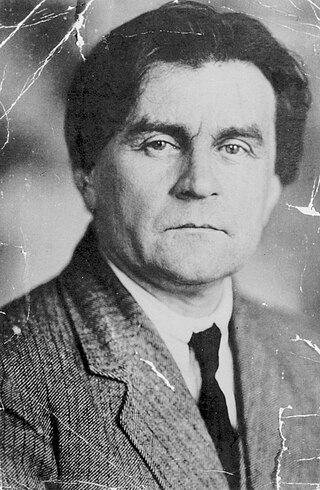
Kazimir Severinovich Malevich was a Russian avant-garde artist and art theorist, whose pioneering work and writing influenced the development of abstract art in the 20th century. He was born in Kiev, modern-day Ukraine, to an ethnic Polish family. His concept of Suprematism sought to develop a form of expression that moved as far as possible from the world of natural forms (objectivity) and subject matter in order to access "the supremacy of pure feeling" and spirituality. Active primarily in Russia, Malevich was a founder of the artists collective UNOVIS and his work has been variously associated with the Russian avant-garde and the Ukrainian avant-garde, and he was a central figure in the history of modern art in Central and Eastern Europe more broadly.

Abstract art uses visual language of shape, form, color and line to create a composition which may exist with a degree of independence from visual references in the world. Abstract art, non-figurative art, non-objective art, and non-representational art are all closely related terms. They have similar, but perhaps not identical, meanings.

Suprematism is an early twentieth-century art movement focused on the fundamentals of geometry, painted in a limited range of colors. The term suprematism refers to an abstract art based upon "the supremacy of pure artistic feeling" rather than on visual depiction of objects.

Monochromatic painting has played a significant role in modern and contemporary Western visual art, originating with the early 20th-century European avant-gardes. Artists have explored the non-representational potential of a single color, investigating shifts in value, diversity of texture, and formal nuances as a means of emotional expression, visual investigation into the inherent properties of painting, as well as a starting point for conceptual works. Ranging from geometric abstraction in a variety of mediums to non-representational gestural painting, monochromatic works continue to be an important influence in contemporary art.

Lyubov Sergeyevna Popova was a Russian-Soviet avant-garde artist, painter and designer.
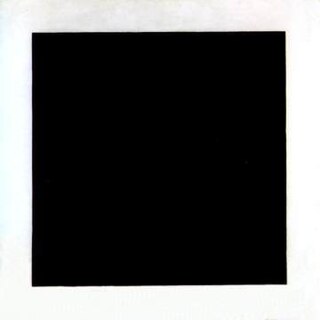
UNOVIS was a short-lived but influential group of artists, founded and led by Russian painter Kazimir Malevich at the Vitebsk Art School in 1919.

Olga Vladimirovna Rozanova was a Russian avant-garde artist painting in the styles of Suprematism, Neo-Primitivism, and Cubo-Futurism.
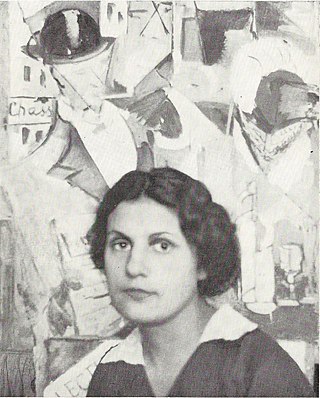
Nadezhda Andreevna Udaltsova was a Russian avant-garde artist, painter and teacher.

El Lissitzky, was a Soviet Jewish artist, active as a painter, illustrator, designer, printmaker, photographer, and architect. He was an important figure of the Russian avant-garde, helping develop suprematism with his mentor, Kazimir Malevich, and designing numerous exhibition displays and propaganda works for the Soviet Union.

Michael Vasilyevich Matyushin was a Russian painter and composer, leading member of the Russian avant-garde.
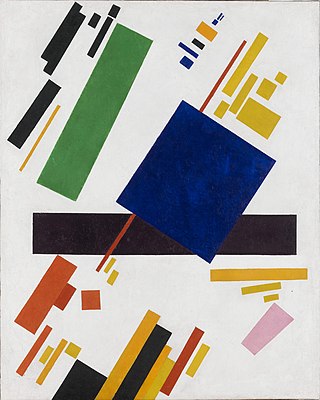
Suprematist Composition (blue rectangle over the red beam) is a 1916 painting by Kazimir Malevich, Russian painter of geometric abstraction.

Ilya Grigorevich Chashnik was a suprematist artist, a pupil of Kazimir Malevich and a founding member of the UNOVIS school.
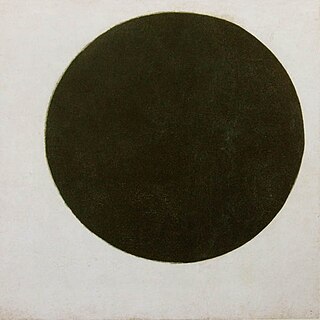
Black Circle is a 1924 oil-on-canvas painting by the Kyiv-born Russian artist Kazimir Malevich, founder of the Suprematism movement. From the mid-1910s, Malevich abandoned any trace of figurature or representation from his paintings in favour of pure abstraction.

The Last Futurist Exhibition of Paintings 0,10 was an exhibition presented by the Dobychina Art Bureau at Marsovo Pole, Petrograd, from 19 December 1915 to 17 January 1916. The exhibition was important in inaugurating a form of non-objective art called Suprematism, introducing a daring visual vernacular composed of geometric forms of varying colour, and in signifying the end of Russia's previous leading art movement, Cubo-Futurism, hence the exhibition's full name. The sort of geometric abstraction relating to Suprematism was distinct in the apparent kinetic motion and angular shapes of its elements.

Painterly Realism of a Peasant Woman in Two Dimensions, also known as Red Square, is a 1915 painting by Kazimir Malevich. Red Square was part of Malevich's Suprematist art movement (1915-1919), which aimed to create artworks that were universally understood.
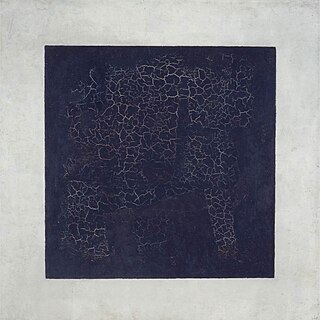
Black Square is a 1915 oil on linen canvas painting by the Russian avant-garde artist and theorist Kazimir Malevich. There are four painted versions, the first of which was completed in 1915 and described by the artist as his breakthrough work and the inception of his Suprematist art movement (1915–1919).
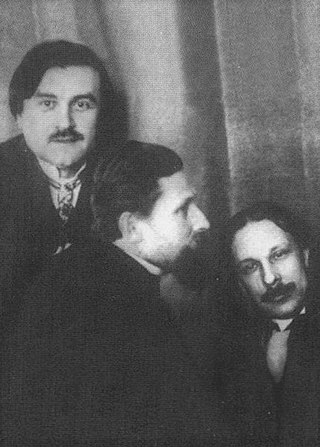
Aleksei Alekseevich Morgunov was a Russian Avant-Garde painter. His works were originally in the Neo-Primitivist style, but became influenced by Fauvism. Together with Kazimir Malevich and Ivan Kliun, he created a style known as "Februaryism". He later took up Neo-Classicism, then was forced to adopt the Socialist Realism model.
Anna Aleksandrovna Kogan (1902–1974) was a Soviet artist. She was a modernist who worked in several media, including painting, textiles, ceramics, glass and sculpture.

An Englishman in Moscow, is a 1914 oil on canvas painting by Russian avant-garde artist and art theorist Kazimir Malevich.
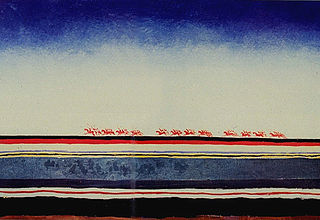
Red Cavalry is an oil on canvas painting of 1932 by the Russian avant-garde artist Kazimir Malevich. It depicts Red Cavalry horsemen racing across a plain, the ground beneath them illustrated with Suprematist stripings of color. It is considered Malevich's only contribution into the pantheon of Soviet art; Malevich intentionally dated the work to 1918, and added the blurb “From the capital of the October Revolution, the Red Cavalry rides to defend the Soviet frontier” on the back.



















